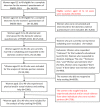Witnessing inter-parental violence in childhood and help-seeking behaviours in violence against women in Peru
- PMID: 38609932
- PMCID: PMC11015581
- DOI: 10.1186/s12889-024-18467-0
Witnessing inter-parental violence in childhood and help-seeking behaviours in violence against women in Peru
Abstract
Background: Violence against women (VAW) severely impacts their physical and mental health. In some cultures, women can normalize certain types of violence if they were linked to home models in childhood and, eventually, do not seek for help in adulthood. We aimed to determine, in Peruvian women, (1) the association between witnessing violence in their family of origin and VAW experienced in adulthood, (2) the extent to which women who have experienced VAW seek some help, and (3) identify VAW prevalence by Peruvian region.
Methods: Cross-sectional study of secondary data obtained from the 2019 National Demographic and Family Health Survey (ENDES). The outcome was VAW (psychological, physical and sexual violence), whereas the exposure was witnessing violence in the home of origin. Help-seeking behavior was a secondary outcome, for which VAW was the exposure. Prevalence ratios (PR) were estimated to assess both associations, unadjusted and adjusted for covariates (aPR).
Results: Data from 14,256 women aged 15 to 49 years were analysed. 51.5% reported having experienced VAW and 43.8% witnessed violence in the home of origin during childhood. Witnessing inter-parental violence in childhood was associated with psychological violence aPR = 1.25 (95% CI: 1.17-1.33), physical aPR = 1.52 (95% CI: 1.38-1.67), and sexual aPR = 1.99 (95% CI: 1.57-2.52). Women who have experienced both types of violence (physical and sexual) were more likely to help-seeking (aPR = 1.30, 95% CI: 1.14-1.50) than women suffering only one type of violence.
Conclusion: Women who reported having witnessed home violence in their childhood are more likely to experience Violence Against Women (VAW) by their current partner. Physical and sexual violence with a current partner was more associated with witnessing inter-parental violence in childhood, and when physical and sexual violence jointly occurred women were more help-seeking. The southern region of Peru is identified as an area of high vulnerability for women. It is crucial to promote educative and community-based programs aimed at the prevention and early recognition of VAW.
Keywords: Help-seeking behaviours; Peru; Violence against women; Witnessing violence.
© 2024. The Author(s).
Conflict of interest statement
The authors declare no competing interests.
Figures
Similar articles
-
Association between history of interparental violence and alcohol abuse among reproductive-age women: Evidence from the Peruvian Demographic and Health Survey.Womens Health (Lond). 2024 Jan-Dec;20:17455057241277533. doi: 10.1177/17455057241277533. Womens Health (Lond). 2024. PMID: 39287602 Free PMC article.
-
Association between witnessing domestic violence against the mother in childhood and intimate partner violence in adulthood: A population-based analysis of Peru.Eur J Obstet Gynecol Reprod Biol X. 2023 Dec 29;21:100275. doi: 10.1016/j.eurox.2023.100275. eCollection 2024 Mar. Eur J Obstet Gynecol Reprod Biol X. 2023. PMID: 38274244 Free PMC article.
-
Factors associated with non-help-seeking among women victims of physical or sexual intimate partner violence in Peru: Findings from the National Demographic and Family Health Survey, 2017 to 2019.Int J Soc Psychiatry. 2024 May;70(3):470-481. doi: 10.1177/00207640231216357. Epub 2023 Dec 27. Int J Soc Psychiatry. 2024. PMID: 38149362
-
Risk factors for violence against women in high-prevalence settings: a mixed-methods systematic review and meta-synthesis.BMJ Glob Health. 2022 Mar;7(3):e007704. doi: 10.1136/bmjgh-2021-007704. BMJ Glob Health. 2022. PMID: 35296455 Free PMC article.
-
Bridging the gaps: a global review of intersections of violence against women and violence against children.Glob Health Action. 2016 Jun 20;9:31516. doi: 10.3402/gha.v9.31516. eCollection 2016. Glob Health Action. 2016. PMID: 27329936 Free PMC article. Review.
Cited by
-
Charting the course of depression care: a meta-analysis of reliability generalization of the patient health questionnaire (PHQ- 9) as the measure.Discov Ment Health. 2025 Apr 7;5(1):50. doi: 10.1007/s44192-025-00181-x. Discov Ment Health. 2025. PMID: 40195248 Free PMC article.
-
Association between intimate partner violence and depressive symptoms across household wealth levels in women of reproductive age in Peru.Womens Health (Lond). 2025 Jan-Dec;21:17455057251351410. doi: 10.1177/17455057251351410. Epub 2025 Jul 6. Womens Health (Lond). 2025. PMID: 40618231 Free PMC article.
References
-
- Violence against women. [cited 2022 Apr 26]. https://www.who.int/news-room/fact-sheets/detail/violence-against-women.
-
- Risk and Protective Factors for Intimate Partner Violence Against Women. Systematic Review and Meta-analyses of Prospective–Longitudinal Studies| AJPH|. [cited 2023 Jan 2];108(7). https://ajph.aphapublications.org/doi/full/10.2105/AJPH.2018.304428. - PMC - PubMed
-
- Physical Health Outcomes of Childhood Exposure to Intimate Partner Violence. A Systematic Review| Pediatrics| American Academy of Pediatrics. [cited 2023 Jan 2]. https://publications.aap.org/pediatrics/article-abstract/117/2/e278/6846.... - PubMed
-
- Bair-Merritt MH, Blackstone M, Feudtner C. Physical Health Outcomes of Childhood Exposure to Intimate Partner Violence: A Systematic Review. Pediatrics. 2006 [cited 2023 Feb 28];117(2):e278–90. 10.1542/peds.2005-1473. - PubMed
-
- World Health Organization. Violence against women prevalence estimates. 2018: global, regional and national prevalence estimates for intimate partner violence against women and global and regional prevalence estimates for non-partner sexual violence against women. Geneva: World Health Organization; 2021 [cited 2022 Oct 7]. https://apps.who.int/iris/handle/10665/341337.
MeSH terms
LinkOut - more resources
Full Text Sources
Research Materials
Miscellaneous



